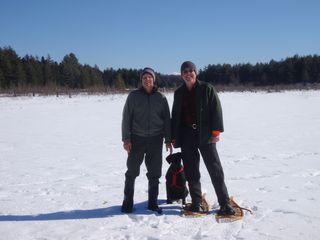 “Crunch, crunch, crunch.” The sound of my snowshoes mark our progress slowly down the flowage in northern Maine. Our group of five NRCM members, including our treasurer, Chris Bond (pictured, on the right), is embarking on our annual winter camping trip along this quiet waterway. Traditional camping with toboggans, snowshoes, canvas tents, and portable wood stoves bonds us to the winter landscape with a dependence on wood to heat and cook, water beneath the ice, and an unparalleled landscape of spectacular scenery. Delicate ice conditions created by the vagaries of flowing water and changing levels call for slow, methodical transit, perfect for our pace, but dangerous to fast-moving motorized travel. So we have peace and quiet, but also a few anxious moments.
“Crunch, crunch, crunch.” The sound of my snowshoes mark our progress slowly down the flowage in northern Maine. Our group of five NRCM members, including our treasurer, Chris Bond (pictured, on the right), is embarking on our annual winter camping trip along this quiet waterway. Traditional camping with toboggans, snowshoes, canvas tents, and portable wood stoves bonds us to the winter landscape with a dependence on wood to heat and cook, water beneath the ice, and an unparalleled landscape of spectacular scenery. Delicate ice conditions created by the vagaries of flowing water and changing levels call for slow, methodical transit, perfect for our pace, but dangerous to fast-moving motorized travel. So we have peace and quiet, but also a few anxious moments.
I have it easier than my campmates as my Lab, Holly, has agreed to pull my toboggan in exchange for a warm sleeping bag to curl up in (that turned out to be Chris’) and the opportunity to continuously harass the group to throw sticks for her to retrieve while in camp. And we weren’t alone. A moose tested the safety of the river ice for almost a mile ahead of us before we caught up with him and he left the waterway to us and its safety assessment to our axes. The tracks of coyote, otter, mink, fox, and snowshoe hare crossed the river regularly. Where the river narrowed and tall spruce replaced the alders, we saw flocks of White-winged Crossbills using their oddly shaped bills to feed on the abundant spruce cones. When we stopped to feed ourselves, families of Canada Jays were at our feet for handouts, storing whatever they picked up in a nearby tree and returning hurriedly for more.
More than animals accompanied us as we lay on our backs looking up through the tree canopy at the night sky. Countless stars seemed brighter than when viewed from anywhere else. Sunrise revealed a snow-capped Mt. Katahdin looking down over us.
If all this seems like a dream, it isn’t. Our experience was the result of a little planning and moderate exertion, but mostly the fore thought and vision of those who have for generations held these lands in trust for all of us. Experiences like these are vulnerable. Fragmentation, development, and motorized access are among the many pressures on the forested landscape of the Unorganized Territories (UT) that threaten the future for users like me, my partners, and our children. For the last 40 years, since its creation by the Maine Legislature, the Land Use Regulation Commission (LURC) has overseen the UT, providing wise stewardship to these lands. No government body satisfies everyone all the time, and this is true for LURC. However, LD 1798 goes way too far in its attempt to restructure the Commission, allowing individual counties to opt out of LURC and county commissioners to appoint themselves to LURC without the usual legislative oversight. Further undermining LURC’s authority would be a proposal contained within LD 1798 to transfer most of LURC’s permitting to the Department of Environmental Protection. Finally, there would be removal of “demonstrated need” as a fundamental criterion, opening the door to speculative development.
I tried not to think of all this while I slowly re-entered civilization, but the importance of it was driven home when I attended State House Action Day several days later on Feb 28th. Speaking to our legislators is very interesting and important. As a citizen legislature, they have hundreds of bills to review and vote on. Your passion for a particular bill often allows you to communicate valuable information and points about the legislation they might not have known.
Become a citizen activist and share your thoughts about LD 1798 and other bills with your legislators. If our generation can join the long list of those who came before us, then just maybe I can share a winter camping trip like this one with my grandchildren. Thanks!
Tony Owens, NRCM member










